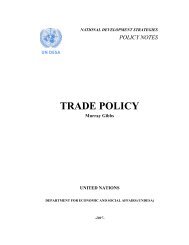Guidelines on the Safe Use of Urine and Faeces in ... - EcoSanRes
Guidelines on the Safe Use of Urine and Faeces in ... - EcoSanRes
Guidelines on the Safe Use of Urine and Faeces in ... - EcoSanRes
Create successful ePaper yourself
Turn your PDF publications into a flip-book with our unique Google optimized e-Paper software.
Carol<strong>in</strong>e Schönn<strong>in</strong>g <strong>and</strong> Thor Axel Stenström<br />
Figure 5. Open defecati<strong>on</strong> is a<br />
major route <strong>of</strong> c<strong>on</strong>tam<strong>in</strong>ati<strong>on</strong> <strong>of</strong><br />
enteric <strong>and</strong> parasitic diseases.<br />
O<strong>the</strong>r <strong>in</strong>dividuals <strong>and</strong> <strong>the</strong> home<br />
envir<strong>on</strong>ment may be affected<br />
through direct c<strong>on</strong>tact <strong>and</strong> also<br />
by walk<strong>in</strong>g barefoot. In additi<strong>on</strong>,<br />
surface water sources may be<br />
heavily impacted.<br />
Treatment could be primary, i.e. directly <strong>in</strong> <strong>the</strong> toilet <strong>in</strong> relati<strong>on</strong> to defecati<strong>on</strong>, e.g. by <strong>the</strong> additi<strong>on</strong><br />
<strong>of</strong> ash (fur<strong>the</strong>r described below), or sec<strong>on</strong>dary where <strong>the</strong> material is collected from <strong>the</strong> toilet<br />
(or left <strong>in</strong> <strong>the</strong> toilet with no fur<strong>the</strong>r additi<strong>on</strong> <strong>of</strong> faeces) <strong>and</strong> treated <strong>in</strong> a c<strong>on</strong>trolled way to reduce<br />
pathogens to acceptable limits. Esrey et al. (1998) stated that a comb<strong>in</strong>ati<strong>on</strong> <strong>of</strong> safe storage <strong>and</strong><br />
fast destructi<strong>on</strong> <strong>of</strong> <strong>the</strong> pathogens <strong>in</strong> excreta are needed <strong>in</strong> order to prevent c<strong>on</strong>tam<strong>in</strong>ati<strong>on</strong> <strong>of</strong> <strong>the</strong><br />
envir<strong>on</strong>ment. Barriers are exemplified <strong>in</strong> <strong>the</strong> alternate “F-diagram” (Figure 6).<br />
Figure 6. Barriers required to prevent <strong>the</strong> transmissi<strong>on</strong> <strong>of</strong> disease/spread <strong>of</strong> pathogens, adapted<br />
from Esrey et al. (1998).<br />
Inactivati<strong>on</strong> <strong>of</strong> pathogens will also occur <strong>on</strong> agricultural l<strong>and</strong> after applicati<strong>on</strong> <strong>of</strong> <strong>the</strong> excreta<br />
as fertilizer <strong>and</strong> <strong>on</strong> crops that may have become c<strong>on</strong>tam<strong>in</strong>ated if fertilized dur<strong>in</strong>g growth<br />
or from splashes from <strong>the</strong> soil dur<strong>in</strong>g heavy ra<strong>in</strong>s. This <strong>in</strong>activati<strong>on</strong> with time <strong>and</strong> due to<br />
prevail<strong>in</strong>g envir<strong>on</strong>mental c<strong>on</strong>diti<strong>on</strong>s can provide a barrier aga<strong>in</strong>st exposure from h<strong>and</strong>l<strong>in</strong>g <strong>and</strong><br />
c<strong>on</strong>sumpti<strong>on</strong> <strong>of</strong> crops <strong>and</strong> for humans <strong>and</strong> animals possibly enter<strong>in</strong>g <strong>the</strong> fertilized field. The<br />
<strong>in</strong>activati<strong>on</strong> is dependent <strong>on</strong> ambient temperature, moisture <strong>and</strong> sunsh<strong>in</strong>e (that will <strong>in</strong>crease<br />
10

















